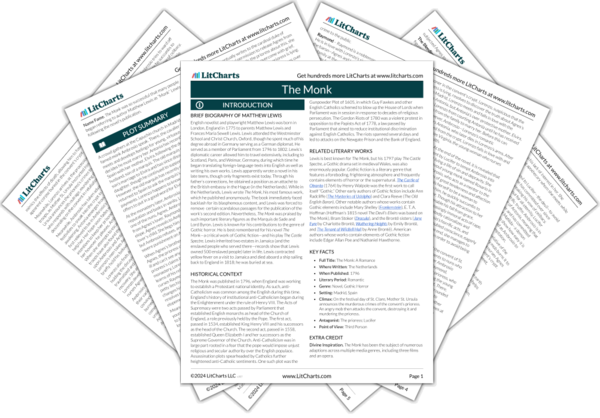Catholicism and Hypocrisy
English author Matthew Lewis wrote The Monk in the late 1700s, a time when England was pushing to adopt a Protestant national identity. The novel thus presents an explicitly negative depiction of Catholicism that would have been common at the time of its initial publication. In particular, Lewis presents a critical perspective on Catholicism by highlighting the hypocrisy of church authority figures and followers, suggesting that Catholic leaders preach a strict moral framework to their…
read analysis of Catholicism and HypocrisyThe Folly of Pride
Although Ambrosio’s fall from pious monk to depraved murderer begins with a relatively benign sin (he succumbs to temptation and breaks his monastic vow of celibacy), his behavior grows increasingly vile as the story unfolds. In an ironic twist, he commits some of his more debauched acts in order to preserve his reputation as a devout and celebrated monk, suggesting that his worst behavior ultimately stems from vanity about his public image. For example…
read analysis of The Folly of PrideMorality
At the time of its initial publication in 1796, The Monk was met with public outcry for its salacious content and scathing condemnation of the Catholic Church. Indeed, the novel is rife with blasphemy, graphic (for the time) depictions of human sexuality, and other taboo subjects, and while many of the story’s “evil” characters are punished for their sins (often quite brutally), many of its innocent characters suffer fates that contradict their virtuous actions. On…
read analysis of Morality
Appearance vs. Reality
The Monk features many characters who assume a certain identity or personality in order to hide their true thoughts or intentions. In addition to creating dramatic tension and comedic relief, this discrepancy between outer behavior and inner reality further serves to highlight the unreliability of appearances as well as the power of perception or expectation to distort reality. For instance, Ambrosio’s devout persona and religious garb conceal his tormented soul and evil sinful urges…
read analysis of Appearance vs. RealityHuman Nature
In The Monk, Ambrosio’s swift fall from grace examines the limitations of religious belief to suppress base human instinct. Although Ambrosio is famous throughout Madrid for his piety and discipline, he is still human, and so he struggles to ward off temptation even from the start of the novel. In the beginning, his religious devotion keeps him in check and allows him to uphold his monastic vows. But the ease with which he…
read analysis of Human Nature






